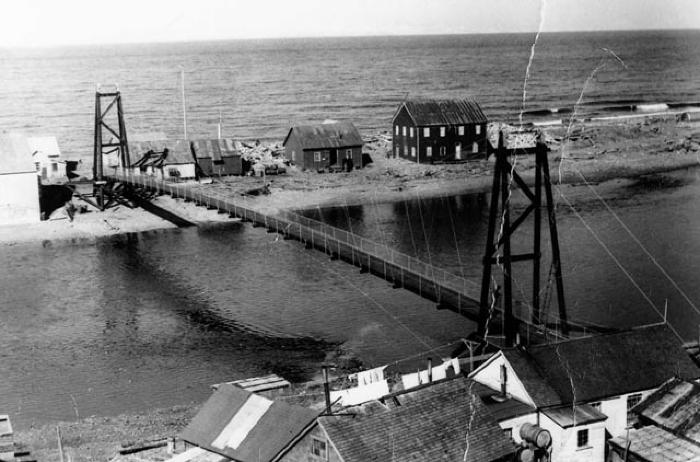Bridge — Arwiryaa'aq

The Alutiiq word arwiryaa'aq means crossing place or ford, and it has come to mean bridge in modern usage. This word is distinct from the term niraq – which refers to a temporary bridge, like a log used to cross a creek or gulley.
While small nirat were probably common in Alutiiq communities, the distribution of ancient settlements suggests that people relied on boats to cross waterways. Along the Karluk River, archaeologists find many old villages where the remains of houses appear on opposite banks. In places, people may have crossed back and forth by wading. Parts of the river are very shallow. But in other places, it would have been easier to paddle. The historic village of Karluk was this way too. Families lived on both shores of Karluk Lagoon. People traveled by boat to go to the store and the post office, attend church, and visit. Historic photos show Karluk children from the north side of the river riding to school on the south side in a skiff. In the coldest weather, when the lagoon froze solidly, people could also walk or ice skate across the mile separating the parts of the community.
In 1940, options for crossing Karluk Lagoon expanded when a suspension bridge was built over the river. This narrow footbridge connected the southern side of the village with Karluk Spit, the gravel beach separating Karluk Lagoon from the ocean waters of Shelikof Strait. From the spit, people could walk to the northern part of the village. The bridge was about and four feet wide, enough for two people to walk side by side when crossing. It features a board-lined walkway and sides of netting.
This bridge functioned until January of 1978 when it was damaged by a severe winter storm. An usually high tide and a storm with intense winds created a new river mouth. Waves washed away the community’s fuel tanks, damaged the bridge and people’s homes, and initiated dramatic erosion. Alaska Governor Jay Hammond declared a disaster and plans to assist the village began. With the approval of the Village Council, the US Department of Housing and Urban Development built 23 new homes for villagers in a more protected location of the lagoon shore.
